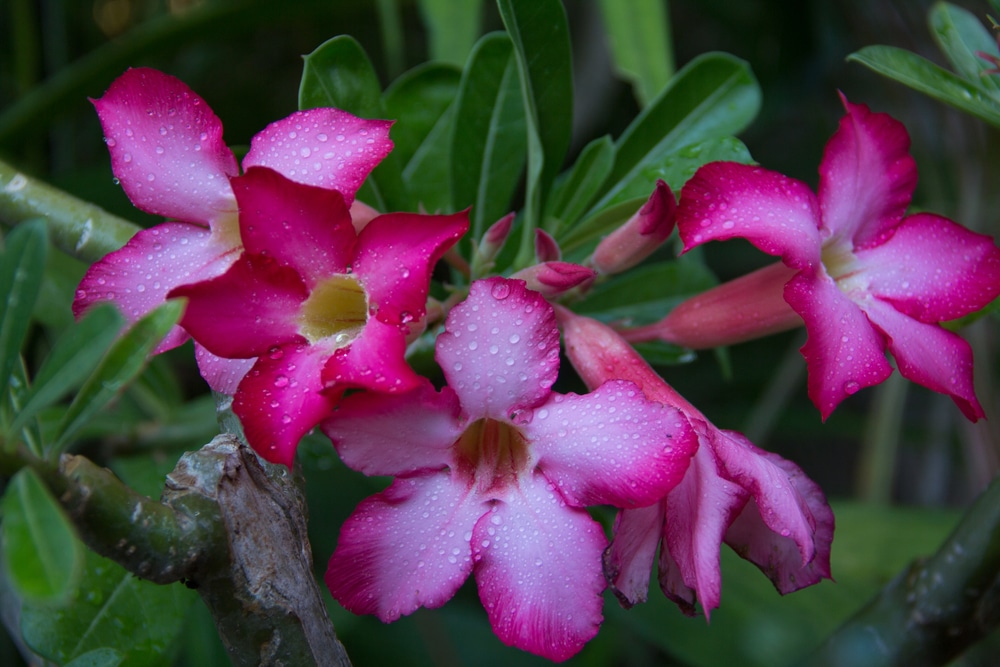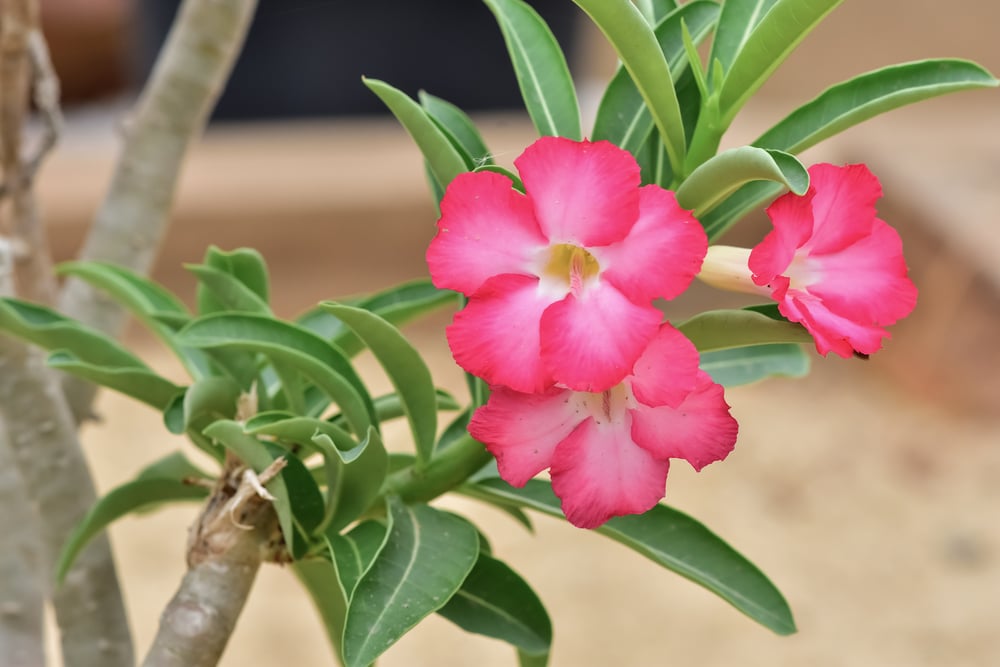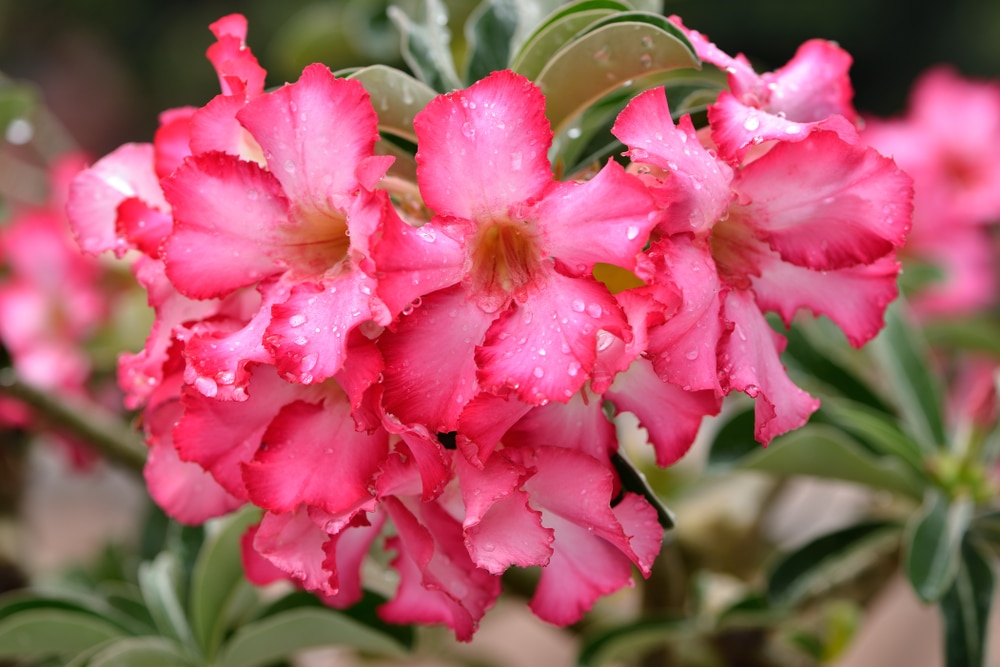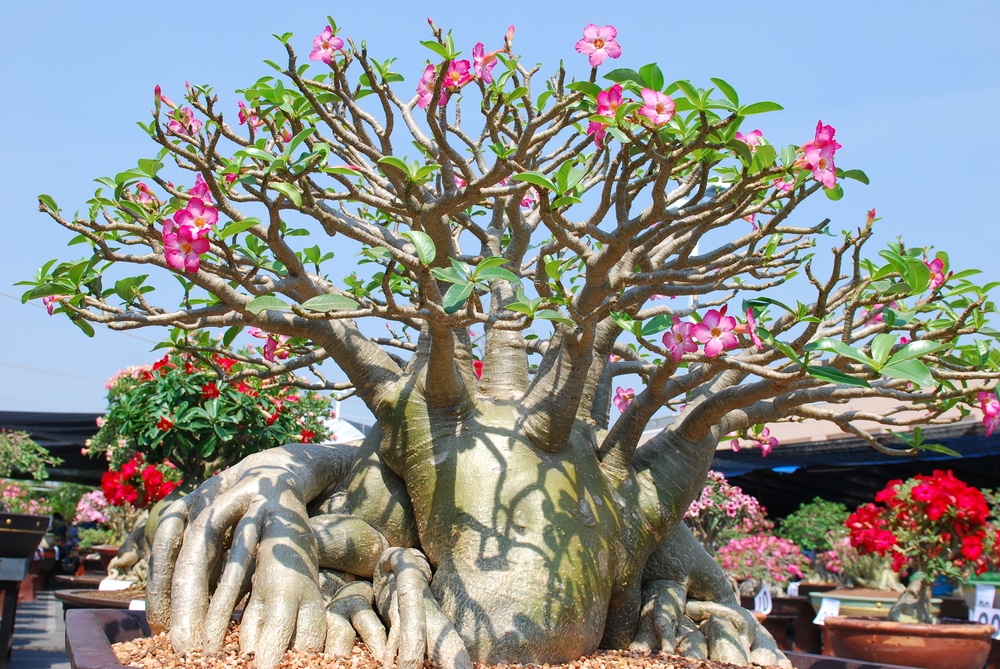Flower Glossary is reader-supported. When you buy through links on our site, we may earn an affiliate commission.
A cactus standout, the desert rose, otherwise known as Adenium obesum, is an elegant yet steadfast succulent that is an ideal choice for gardeners of all levels.
Native to the East African and Arabian peninsula, desert rose makes a beautiful addition to both warm climate gardens and greenhouses, alike, but how do you go about growing and caring for them?

Not your typical flower or plant, if you want to have one of your own, then you’re going to need to emulate similar conditions to where it natively grows.
This means that in order for a desert rose to thrive, it’s going to need plenty of sun, dry soil, and some green fingers to help it along its way – that’s where you come in!
Before you get planting, though, you’re going to need to know the ins and outs of this resilient flower, and that’s where we come in to lend a helping hand.
Below, you’ll find everything there is to know about desert roses. From conditions needed to plant it, insights on how to ensure it grows, as well as tips and tricks for caring for it once it has fully bloomed in your garden.
So, without further ado, pen and notebook at the ready? Let’s jump right in.
Table of Contents
What is Desert Rose?

The desert rose (otherwise known as Adenium obesum) is a plant that tends to only grow around 12 inches a year, and that’s with optimum growing conditions. It has a very thick plant stem and blooms vibrant and eye-catching pink flowers, which is a visual feature that has made the desert rose to gain much popularity as an ornamental garden plant.
Regardless of whether you’re a seasoned gardener or not, you’ve likely already noticed the desert rose’s resemblance to the bonsai plant, especially due to its short and wide stature and eye-catching pink flowers.
However, unlike the bonsai plant which many gardeners can find difficult to care for, the desert rose is actually quite easy and low maintenance to maintain, especially when you have ensured the living conditions.
An Adenium, the desert rose is native to Madagascar, east Africa as well as the Arabian Peninsula, and is characterized by its thick, swollen plant stem (or trunk).
The main reason the desert rose plant has this large trunk is due to the dry climates it originates from, in which there are extremely long periods of time in which no rainfall occurs.
For this reason, in order to survive, the desert rose (as well as all other types of succulent plants) has evolved to have its very own water storage system that allows it to survive extremely long periods of dry and hot weather without dying.
As you might have already guessed, desert rose is able to cultivate this water storage system by making use of its larger steam.
During periods of drought, the desert rose will be able to swell out its trunk in order to preserve and keep water, and the fatter the trunk of a desert rose, the healthier it will be.
How do you grow desert roses?

Prior to planting your desert rose, you’re first going to need to double-check as to whether or not you live in a climate that is suitable for a desert rose plant to grow.
If not, then you will need to plant your desert rose indoors. In the USA, the desert rose can only grow outdoors in USDA zones 11 and 12, all other locations are not suitable for a desert rose plant to grow in an outdoor environment.
Once you have discovered whether your desert rose succulent needs to be planted indoors or outdoors, you’re then going to need to pick the optimum location.
If you’re planting it indoors, then pick a windowsill or area of the house that gets plenty of direct sunlight throughout the day, and if you’re planting it outdoors, you’ll need to pick a spot that gets ample sunlight with just a little bit of shading.
The soil that you use is very important, as it can’t be too moist. The perfect soil for a desert rose to be planted within should be sandy and dry in texture, with a neutral-acidic pH that falls to around 6.0.
The soil you have planted your desert rose plant in will need to remain moist at all times, ensuring that before each watering session, you have given the soil enough time to dry a little.
We also recommend keeping your desert rose in a terracotta pot, as this will help to prevent any rotting caused by too much moisture.
How do you care for a desert rose?

Once your desert rose plant has fully grown, the next thing you will need to do is regularly tend to it. Taking good care of a desert rose plant is surprisingly easy, though you will need to make sure you have some know-how of how to care for Adeniums, first.
Generally speaking, when it comes to the successful growth and life of a desert rose plant, it’s absolutely essential that it’s getting exposed to plenty of direct sunlight, as well as lots of regular water.
On top of this, desert rose thrives in extremely warm temperatures (due to the climate of its native countries) which is why, except for USDA zones 11 and 12, a desert rose must be an indoor plant, otherwise it will not have the correct living conditions to survive.
In addition to this, it’s also worth noting that the desert rose plant most commonly blooms during the warm, summer months, in which beautiful and vibrant Fuschia pink flowers burst from its branches.
Then, in the colder winter months, the desert rose tends to lose all of its green leaves and flowers and remains dormant until the next summer season.
During both periods of bloom and dormancy, your desert rose plant will need to be exposed to a direct sunlight environment, so you’ll need to keep it in an area of your home that catches plenty of sunlight throughout the day.
Alternatively, if you live in a climate where a desert rose plant is able to thrive in the outdoors, then you should make sure that you plant it in an area of your garden that does not experience much shade.
Ideally, your desert plant should grow in an area of your garden that catches ample sunlight, but has a little bit of shading so that your desert rose plant will be protected from the sun when it reaches the highest point, as the belting heat can often cause the leaves and petals of a desert rose plant to become burnt.
Additionally, as we mentioned a little earlier on, in order for your desert rose plant to thrive you will need to make sure that the soil maintains a neutral to an acidic environment (optimum level being 6.0) as these soil conditions are extremely similar to that of the desert conditions the desert rose plant is used to growing and living within.
As a side note, it’s extremely important to be aware that the sap released by a desert rose plant is extremely poisonous to humans and animals, so it’s very important to ensure that it stays far out of the reach of any pets that you might have, as well as young children.